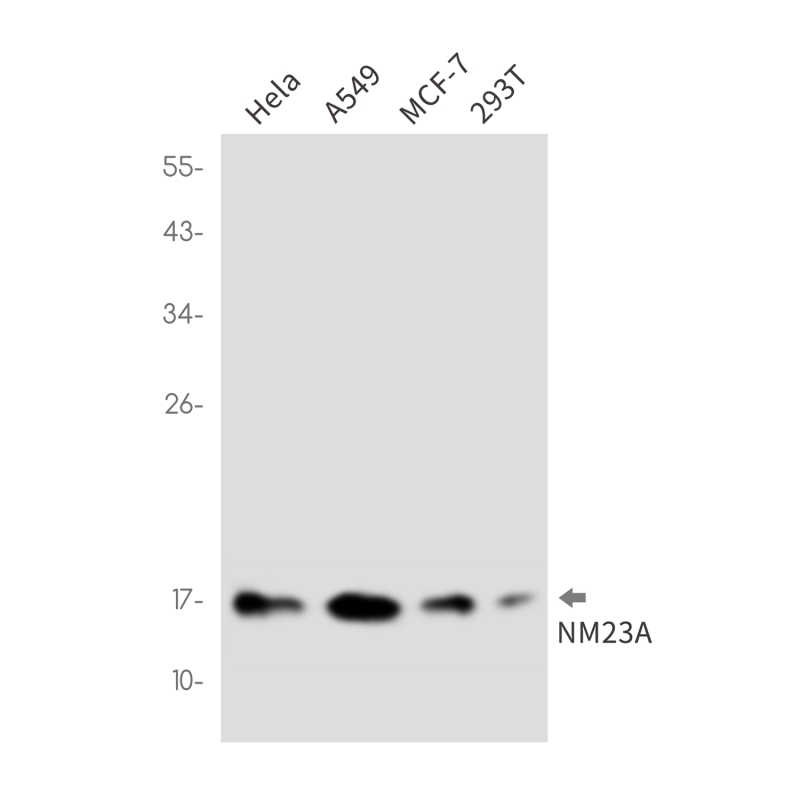
| WB | 1/500-1/1000 | Human,Mouse,Rat |
| IF | 咨询技术 | Human,Mouse,Rat |
| IHC | 咨询技术 | Human,Mouse,Rat |
| ICC | 技术咨询 | Human,Mouse,Rat |
| FCM | 咨询技术 | Human,Mouse,Rat |
| Elisa | 咨询技术 | Human,Mouse,Rat |
| Aliases | NME1; NDPKA; NM23; Nucleoside diphosphate kinase A; NDK A; NDP kinase A; Granzyme A-activated DNase; GAAD; Metastasis inhibition factor nm23; Tumor metastatic process-associated protein; nm23-H1 |
| Entrez GeneID | 4830 |
| WB Predicted band size | Calculated MW: 17 kDa; Observed MW: 17 kDa |
| Host/Isotype | Rabbit IgG |
| Antibody Type | Primary antibody |
| Storage | Store at 4°C short term. Aliquot and store at -20°C long term. Avoid freeze/thaw cycles. |
| Species Reactivity | Human |
| Immunogen | A synthetic peptide of human NM23A |
| Formulation | Purified antibody in TBS with 0.05% sodium azide,0.05%BSA and 50% glycerol. |
+ +
以下是关于NM23A抗体的模拟参考文献示例(仅供学术参考,实际文献需通过数据库查询):
---
1. **文献名称**:*NM23A Expression in Breast Cancer: Correlation with Metastatic Potential*
**作者**:Smith, J.R., et al.
**摘要**:本研究通过免疫组化(IHC)和Western blot分析NM23A蛋白在乳腺癌组织中的表达水平,发现NM23A低表达与淋巴结转移和不良预后显著相关。抗体特异性通过siRNA敲除实验验证,证实其在临床样本中的应用可靠性。
2. **文献名称**:*Functional Characterization of NM23A in Melanoma Cell Migration*
**作者**:Lee, H., et al.
**摘要**:利用NM23A特异性抗体进行免疫荧光染色和流式细胞术,揭示NM23A通过调控细胞骨架重组抑制黑色素瘤细胞的迁移能力。研究还发现,过表达NM23A可降低ERK信号通路的激活水平。
3. **文献名称**:*NM23A as a Biomarker in Colorectal Cancer: Validation of Antibody Specificity*
**作者**:Garcia, M., et al.
**摘要**:系统评估了多种商业NM23A抗体的特异性,发现克隆号H1的抗体在结直肠癌组织中表现最佳。该研究结合质谱数据,证实抗体在区分NM23A与其他同源蛋白(如NM23B)中的高选择性。
4. **文献名称**:*NM23A Modulates DNA Repair Pathways via Interaction with p53*
**作者**:Wang, Y., et al.
**摘要**:通过免疫共沉淀(Co-IP)和ChIP实验(使用NM23A抗体),证明NM23A与p53蛋白相互作用,增强DNA损伤修复能力。研究提示NM23A可能通过此机制抑制肿瘤基因组不稳定性。
---
如需真实文献,建议通过PubMed或Google Scholar检索关键词:**NM23A/NME1 antibody** + **cancer/metastasis/functional study**。
**Background of NM23A Antibody**
The NM23A antibody targets the NM23A protein, also known as NME1 (Non-Metastatic Protein 23 Homolog A), a member of the nucleoside diphosphate kinase (NDPK) family. NM23A was initially identified as a metastasis suppressor in murine melanoma models, where its reduced expression correlated with increased metastatic potential. This protein plays dual roles in cellular processes: it regulates nucleotide metabolism via its NDPK activity, maintaining nucleotide pools for DNA/RNA synthesis, and acts as a transcriptional modulator influencing genes linked to differentiation, apoptosis, and metastasis.
Structurally, NM23A forms hexamers and interacts with various proteins, including kinases, histones, and cytoskeletal components, impacting cell motility and signal transduction. Its involvement in cancer progression, particularly metastasis inhibition, has made it a focus in oncology research. NM23A dysregulation is also implicated in developmental disorders, such as neurodevelopmental defects, and other pathologies like neurodegenerative diseases.
The NM23A antibody is widely used in research applications, including Western blotting, immunohistochemistry, and immunofluorescence, to study protein expression, localization, and functional mechanisms in disease models. Its specificity helps elucidate NM23A's role in tumor suppression, metastasis, and cellular homeostasis, aiding therapeutic and diagnostic advancements. Variants and post-translational modifications (e.g., phosphorylation) further diversify its functions, making the antibody a critical tool for dissecting NM23A's complex biological roles.
×